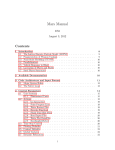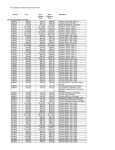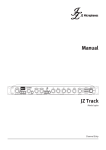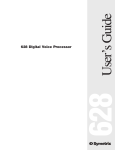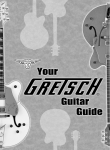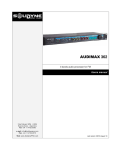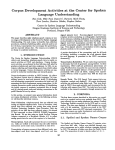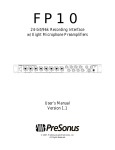Download VPre manual version 1.0
Transcript
User Manual Last Revised 1 June 2010 © VSonics Limited 2010 1 End User License Agreement PLEASE READ THE FOLLOWING LEGAL AGREEMENT CAREFULLY PRIOR TO USING THE VPRE SOFTWARE PROVIDED WITH THIS AGREEMENT. USE OF THE SOFTWARE CONSTITUTES YOUR ACCEPTANCE OF THE TERMS OF THIS LICENSE. IF YOU DO NOT AGREE TO THE TERMS OF THIS LICENSE, PROMPTLY APPLY TO US FOR A REFUND. 1. License The software accompanying this License, whether on disc, in memory or on any other media (the "Software"), and the related documentation are licensed to you by VSonics Limited (the "Company"). You may use the Software on a single computer and make one copy of the Software for backup purposes only. If you have multiple Licenses for the Software, then at any time you may have as many copies of the Software in use as you have Licenses. The Software is "in use" on a computer when it is loaded into the temporary memory (RAM) or installed into the permanent memory (e.g., hard disk, CD-ROM, or other storage device) of that computer, except that a copy installed on a network server for the sole purpose of distribution to other computers is not "in use”. If the anticipated number of users of the Software will exceed the number of applicable Licenses, then you must have a reasonable mechanism or process in place to assure that the number of persons using the Software concurrently does not exceed the number of Licenses. 2. Copy and use restrictions You are not allowed to distribute copies of the Software or the documentation. This Software is protected by the copyright laws that pertain to computer software. It is illegal to make copies of the Software, except for backups. It is illegal to give copies to another person, or to duplicate the Software by any other means, including electronic transmission. The Software contains trade secrets and in order to protect them you may not decompile, reverse engineer, disassemble or otherwise reduce the software to human-perceivable form. You may not modify, adapt, translate, rent, lease or create derivative works based upon the Software or any part thereof. You may not provide use of the Software in a network, time-sharing, or multiple user arrangement without purchasing the appropriate number of Licenses as described in paragraph 1. above. You may not electronically transmit the Software from one computer to another. You acknowledge that no title to the intellectual property in the Software is transferred to you and that title and full ownership rights to the Software will remain the exclusive property of the Company or its suppliers and licensors. If the Software is an update to a previous version (the "Update"), you must possess a valid License for the previous version, in order to use the Update. All Updates are provided to you on a "license exchange" basis and you agree that by using an Update, you no longer have a License to use any previous version of the Software. 3. Termination This License is effective until terminated. You may terminate this License at any time by destroying all copies and recordings of the licensed software and documentation and giving a legally binding written assurance to the Company that you have done so. This License will terminate immediately without notice from the Company if you fail to comply with any provision of this License. Upon termination you must destroy all copies and recordings of the Software, related documentation and copies thereof and return to the Company the originals of the Software and documentation. 4. Limited Warranty The Company warrants that the Software will perform substantially in accordance with the accompanying written materials for a period of (90) ninety days from the date of receipt. 5. Customer Remedies The Company's entire liability and your exclusive remedy shall be, at the Company's' option, either (a) return of the price paid or (b) replacement of the Software that does not meet the Company's Limited Warranty and that is returned to the Company with a copy of your receipt. This Limited Warranty is void if failure of the Software has resulted from accident, abuse, or misapplication. Any replacement Software will be warranted for the remainder of the original warranty period. This warranty gives you specific legal rights and you may also have other rights which vary by jurisdiction. 6. No Other Warranties EXCEPT FOR THE EXPRESS WARRANTY OF THE ORIGINAL SOFTWARE SET FORTH ABOVE, THE COMPANY GRANTS NO OTHER WARRANTIES, EXPRESS OR IMPLIED, BY STATUTE OR OTHERWISE, REGARDING THE SOFTWARE, ITS FITNESS FOR ANY PURPOSE, ITS QUALITY, ITS MERCHANTABILITY OR OTHERWISE. THE LIABILITY OF THE COMPANY UNDER THE WARRANTY SET FORTH ABOVE SHALL BE LIMITED TO THE AMOUNT PAID BY THE CUSTOMER FOR THE PRODUCT. 7. No Liability For Consequential Damages In no event shall the Company or its suppliers be liable for any damages whatsoever (including, without limitation, direct, indirect, punitive, special, incidental, or consequential damages, or damages for loss of business profits, business interruption, loss of business information, or other pecuniary loss) arising out of the use of or inability to use the Software, even if the Company has been advised of the possibility of such damages. 8. No Obligation To Enforce Nothing contained in this Agreement shall be construed as imposing on the Company any obligation to acquire, maintain, or file or defend any suit or action regarding the validity or infringement of, any of the Company's intellectual property licensed hereunder. 9. No Support Obligation The Company is not obligated to furnish or make available to you any further information, software, technical information, knowhow, or support. The Company reserves the right to make changes to the Software, and all materials provided hereunder, without further notice. 10. Severability In the event any provision of this Agreement is determined to be invalid or unenforceable, it shall be adjusted so as to best reflect the intent of the parties to the maximum extent possible, and the remainder of this agreement shall be valid and enforceable to the maximum extent possible. 11. Entire Agreement This Agreement is the entire understanding between the parties with respect to the subject matter hereof and replaces any previous discussion and/or agreement regarding such subject matter. No amendment to or modification of this License will be binding unless in writing and signed by the Company. 12. Governing Law This Agreement shall be interpreted and enforced in accordance with English law and the English courts shall have jurisdiction to determine any dispute. 2 1. Introduction ........................................................................................................... 4 2. How to Install ........................................................................................................ 5 3. Basics ...................................................................................................................6 3.1 User Interface .................................................................................................. 6 3.2 Signal processors ............................................................................................. 7 4. Getting the Best from VPre ...................................................................................... 9 5. VPre Setup in Pro Tools ..........................................................................................10 6. Reference ............................................................................................................ 12 Sample rates 12 6.1 User Settings ................................................................................................. 12 Changing Settings Re-sizing Hiding parts of the main window 12 12 12 6.2 Signal Processors Reference ............................................................................. 12 High Pass Filter Breath Reduction Expander 12 13 13 Compressor | Limiter De-esser Using the different processors together 13 14 15 6.3 Preferences ................................................................................................... 16 All Meters 16 Input/Output Meter Parameter Description Default settings Apply, OK and Close buttons 16 17 17 17 6.4 Analogue-style meters .................................................................................... 17 BBC ppm (type IIa PPM) EBU ppm (type IIb PPM) VU meter LDPM 17 18 18 19 Reference levels 20 6.5 Presets ......................................................................................................... 20 3 VPre Manual | 1. Introduction 1. Introduction VPre is a Pro Tools RTAS plug-in consisting of a series of signal processors which can be used in any combination to process speech recordings quickly and transparently. It's easy to set up and you'll be able to achieve a standard of work not normally attainable either with multiple processors or in a single plug-in. It's tailored to human speech and can be used to produce either temporary or permanent processing at the time of recording, or as a post production tool. Key features of VPre include • • • • • • • • • Breath reduction Voice optimised expander Gentle voice compressor Limiter High pass filter De-esser Accurate, realistic meters Fast, easy setup Optimised for spoken word Provided you're recording in a room well suited to speech recording, and once you've set your microphone's gain for the best input level to Pro Tools (the plug-in offers a choice of adjustable on-screen meters to help you do this) you won't need any signal processing other than VPre's. For quick, efficient studio setup, you can save and recall your own presets. Compressor, expander, limiter, de-esser and intelligent breath reduction all look ahead without introducing unmanageable latency. Adjustments are easy. Metering is comprehensive. You'll get clean, realistic, top quality results with no hassle. 4 VPre Manual | 2. How to Install 2. How to Install Double click the VPre Installer.pkg icon and follow the instructions. Once installed, VPre will allocate a machine ID to your computer and allow a 14 day trial of the plug-in. When you're ready to buy the software you can do so at http://www.vpre.net/vpre/store After buying a license you'll be e-mailed the serial number you need to download a key file from http://www.vpre.net/vpre/register - you'll be asked to enter this serial number and the machine ID of the computer you want to use VPre on. Once you have a key file, simply drag and drop the file icon directly over the VPre window to enable permanent use of the software. 5 VPre Manual | 3. Basics 3. Basics Detailed information on all aspects of the plug-in can be found in the Reference section (pages 12 - 20). 3.1 User Interface Most of the screen shots in this manual show mono tracks. With stereo, you get twice as many analogue-style meters (see illustration above, page 4). For mono tracks, the VPre window looks like this. In the main window the analogue-style meter on the left shows the input level, while the one to the right shows output. Each processor has its own section, with a large bypass button. Note that the high pass filter is active when the button's symbol is illuminated, whereas the others are bypassed when illuminated. Standard Pro Tools procedure enables you to save your own presets by pointing and clicking at the arrows to the left of the Presets field (known as the Pro Tools "Librarian Menu") and following the path as appropriate (see your Pro Tools reference guide for more details). In the preferences window, you can make your choice of analogue-style meters, as well as going through the necessary business of setting the meters' reference levels to match your 6 VPre Manual | 3. Basics studio's. The preferences window is accessed via the 'prefs' link at the bottom left of the main window. In either window, settings can be altered by dragging sliders left or right (holding down the ctrl key while you drag produces finer increments) or by pointing and clicking on numbers to reveal a field where you type the setting you want. 3.2 Signal processors If you already know about compression, expansion and de-essing, you won't need to read this section but you may like to find out about Breath Reduction processing which is described below, and on page 13 in the Reference section. Compressors and limiters manage extremes of dynamic range by automatically turning things down when they get too loud. With subtle use of a compressor, you can engineer a situation in which the quiet bits are easy to hear but the loud bits don't blow your ears off, or exceed the system's limits and cause distortion. An expander enables you to render small sections of the recording which contain no useful programme material (for example, the gaps between words in speech) even quieter. This can be very useful, for instance if you are recording in an environment with certain types of undesirable ambient noise. A de-esser is used to reduce or eliminate excess sibilant sounds. These can be caused by compression, microphone choice and technique, or often simply by the characteristics of an individual’s mouth. In addition to these traditional dynamics processors, VPre has an intelligent breath reduction processor, designed to reduce the level of audible breaths in a speech signal. VPre's breath reduction is able to seek out and destroy breaths but it sounds more realistic when you ask it to show mercy and back them off sensitively instead. How do these signal processors function? Compressors reduce the dynamic range of signals that exceed a selected threshold by a specific amount. The increase of input signal needed to cause a 1dB increase in the output signal of the compressor is called the compression ratio. So, for example, with a ratio of 4:1, an 8dB increase of input produces a 2dB increase in the output. A limiter is a special sort of 7 VPre Manual | 3. Basics compressor, used to prevent signal peaks from ever exceeding a chosen level, which conventionally involves compression ratios that would be unsuitable for speech if used on their own. Expanders also have an adjustable threshold and ratio, but expansion can be thought of as the opposite of compression. Whereas compression and limiting take effect whenever the signal goes above the threshold, expansion affects signal levels below the threshold. Signals below the threshold are expanded downwards by the specified ratio. For example, if the ratio is 4:1 and the signal drops 8dB below the threshold, the signal level will be reduced to 32dB below the threshold. Large ratios are generally unsuitable for realistic processing in speech recording and VPre's processors have been designed with this in mind. De-essers process dynamically, only working when the level of the signal in the sibilant range exceeds a set threshold. They differ from equalization, which is a static change in level and can also be used to reduce the level of sibilant frequencies. Breath reduction works by identifying the sound of breaths in a voice signal and processing the result to minimise any perceived imperfection in the recorded performance, according to the user's requirements. This newly designed process offers three different levels of processing with user control of the sensitivity of detection, the thresholds above and below which changes are made and the amount by which detected breaths are reduced. Clear metering lets you know when the processor is active and shows the amount of reduction as it happens. 8 VPre Manual | 4. Getting the Best from VPre 4. Getting the Best from VPre You can use signal processing to remove almost everything that isn't part of the sound of the words you are recording. Ambient noise can be expanded to virtual extinction, the differences in level inherent in most performances can be compressed to something approaching a straight line, with VPre breathing can be made to disappear, and so on. On the other hand, there are audio producers and perhaps some studio engineers who won't allow signal processors anywhere near their work. For example in the past, there was a genuine concern that compressors or expanders would be heard "pumping", to the obvious detriment of natural sound quality. This was especially the case with outboard processing. VPre's processors are designed so that when properly used, it is extremely unlikely they'll be heard working. VPre doesn't want you to hear what it's doing and parts of it think about this first before deciding what to do next. To get the best out of these tools, it's worth considering what goes to make a good speech recording. Each type of work requires its own approach and everyone has their point of view. As an example, here's our view on what's good for a certain type of recording that can involve continuous and sometimes extensive processing. For many purposes, swallows, breaths and lip smacks that don't stick out like a sore thumb at the time of recording need not necessarily be seen as intrusive. On the contrary, these sounds may be considered an acceptable, even necessary part of the performance. For instance, intimacy can be an essential component in single voice audio book production and it can't be achieved properly without retaining most of the natural sounds that are a by-product of reading aloud. For breaths, you might go further and suggest that it could actually be both technically and artistically wrong to remove them. It's hard to believe you are very close to someone if you can't hear them breathing. You don't always want to feel the moisture in your ear but it can happen that the more breaths you remove, the more unnatural the performance sounds. There even comes a point where listening gets uncomfortable. The listener may find it difficult to say why, but short periods of silence can sometimes be more distracting than the natural sounds the processing has replaced. Fortunately, VPre has been designed with these considerations in mind. If the room is a little noisier than you might prefer, expand it gently, without trying to reduce it to an anechoic chamber. If the reader is going to get carried away, you'll find that VPre can compress the signal quite significantly without it becoming obtrusive. The brick wall limiter will pick up the pieces if the performance gets extreme. The breath reduction facility can be used to identify and soften breaths, rather than exclude them completely. VPre enables you to find a happy medium. The voice will sound clean, natural and easy to listen to. Ambient noise and breaths will be reduced to a level that offends no-one. This doesn't mean you can't use VPre in a less realistic way. It's just that, as with all signal processing, the more you process the more you're likely to hear what's being imposed on the signal. If you want it to sound processed, VPre will be just as happy to go for it. 9 VPre Manual | 5. VPre Setup in Pro Tools 5. VPre Setup in Pro Tools There are various different ways VPre can be used within Pro Tools. For example, you can use it to process audio non-destructively in realtime, or you can set it up to destructively process audio on the way in to Pro Tools before it's recorded. Depending on the nature of your project, the latter method might enable you to avoid a time consuming realtime bounce later on. Furthermore, it's possible to record both the processed and unprocessed audio at the same time so that you still have the unprocessed version as a backup in case you need to adjust the processing. Additionally, VPre can be used as a post production tool to enhance voice recordings after the event. Each of the methods outlined below will suit a different set of circumstances. VPre setups for recording • To record unprocessed speech and simultaneously monitor as though it were being processed, simply assign VPre to an insert point on the track to be recorded (from a mono track's insert point, VPre is found under plug-in / Dynamics). The signal from your mic, externally adjusted for level with visual help from the input meter (the LDPM is particularly well suited, see section 6.4 on page 19), will be this track's input. • To record processed speech only, create an Aux Input track with your mic, adjusted for level, as its input and assign VPre to an insert point, before assigning the output of that track to a bus. Create an audio track, assign the same bus to the input and monitor the track's output. What you hear is permanently processed - the signal processing cannot be removed. 10 VPre Manual | 5. VPre Setup in Pro Tools • To record unprocessed speech (as a back-up) together with a permanently processed track, assign VPre to an insert point on the unprocessed track (with your mic, adjusted for level, as its input), then assign the output of that track to a bus. On the second track, assign the same bus to the input and monitor the track's output. What you hear is permanently processed. If there's anything you don't like, you can go back to the unprocessed original (remember to disable "record ready"!), modify the processing as desired and record that section to the second track again. VPre post production setup For post production where the master will be bounced to disk or played out of Pro Tools for mastering on another medium, VPre will be assigned to the voice tracks' insert points as appropriate (from a mono track's insert point, VPre is found under plug-in / Dynamics). 11 VPre Manual | 6. Reference 6. Reference Sample rates VPre is designed for use with the following sample rates: 44.1, 48, 88.2, 96, 176.4, 192kHz. 6.1 User Settings Changing Settings All settings can be changed by dragging the horizontal sliders (hold down control [Windows] or command [Mac] to get smaller increments) or by clicking on numbers to reveal a field in which the desired setting can be typed. Only valid settings are accepted. Re-sizing The main window can be re-sized by clicking and dragging the window's bottom right corner. When you change the size of the window in this way, the dimensions of the analogue-style meters stay the same but they can be changed in the Preferences window (see page 16). Hiding parts of the main window You can choose to hide the meters or the signal processors. Clicking on the small grey triangle at the edge of either section selects that part of the display and hides the rest. Clicking the same triangle again restores the complete window. 6.2 Signal Processors Reference High Pass Filter This filter reduces audio below the frequency of 80Hz by 12dB per octave and is conventionally used to reduce pops and undesirable ambient noise without significantly altering the sound of the voice. The high pass filter is active when the button's symbol is illuminated. 12 VPre Manual | 6. Reference Breath Reduction Recognises breaths and lowers their level according to your settings. The processing is complex. To make it easier to use, the interface has been designed to work like an expander with some extra possibilities. VPre's breath reduction processor has two threshold controls, an upper threshold and a lower threshold. Only material whose levels fall between these two thresholds are checked for breaths. In practise, the lower threshold is useful if you're trying to preserve very quiet breaths in the performance, which can help prevent the recording from sounding too processed. The upper threshold is useful to guard against parts of words occasionally being misdiagnosed as breaths. Although this happens very rarely for most voices, it can lead to an audible drop-out in the middle of a word. The solution is to set the upper threshold so that most of the spoken words are above the threshold (and therefore not processed for breaths) and most of the breaths are below the threshold. VPre's breath detection algorithm is normally very good at spotting what's a breath and what's not. Occasionally, however, you may find that for a particular artist the breath detection performs less well than you're used to. If lots of breaths are being missed and you're sure the thresholds are set correctly, the breath detection algorithm itself can be tweaked via the "tune" control. Positive settings tend to work better for female voices and negative settings for male voices. The tune control should always be left at zero unless you're sure changing it has made a definite improvement to the breath detection for the artist you're recording. Whenever a breath is detected, the yellow "detect" light at the top of the module will illuminate. Mode selection between soft, medium and hard does what you might expect. Whereas soft mode processes breaths gently, hard can be set up so that they often appear to have been removed altogether. The range setting determines the maximum amount by which the level will be reduced. The horizontal gain reduction meter shows processing in dB as it happens. Processing is inactive when the individual Bypass panel is illuminated. Expander The expander reduces the level of any audio below the threshold. The range setting determines the maximum amount by which the level will be reduced. The horizontal gain reduction meter shows processing in dB as it happens. Processing is inactive when the individual Bypass panel is illuminated. Compressor | Limiter Only sound whose level exceeds the threshold will be processed. Each time this happens, the ratio is applied to determine how much the excess will be reduced by. At 2:1, it will be divided by 2 (halved) whereas at 5:1 it will be divided by 5 - in other words the larger the ratio, the greater the reduction in level of sound above the threshold. For some types of music you'd 13 VPre Manual | 6. Reference need relatively high ratios to achieve the results you might expect but for the spoken word, 5:1 is all we're giving you. The object of compression is to smooth out the dynamic range, which the compressor achieves by making certain elements quieter. To compensate for this loss in level, and to maximise signal to noise ratio, it's normal to increase the output gain using the dedicated slider. As usual, the horizontal gain reduction meter shows processing in dB as it happens. Processing is inactive when the individual Bypass panel is illuminated. The limiter prevents VPre's output from going above what you decide is a safe level. Although it behaves like a second compressor, it has a more aggressive compression ratio. The more you lower the threshold the more it will be triggered. For a natural sound the limiter should only be active at rare moments when the system is in danger of overloading. Whenever the limiter is active, the yellow "limit" light at the top of the module will illuminate. The horizontal gain reduction meter shows processing in dB as it happens. Processing is inactive when the individual Bypass panel is illuminated. De-esser VPre's sibilance detection algorithm provides a measure of how sibilant the material being processed is at any given instant. The de-esser threshold control should be set so that the sibilance level displayed on the threshold bar meter only exceeds the threshold when an excessively sibilant sound is heard. When the level of sibilance exceeds the threshold, VPre processes the audio by gently compressing the high frequency range of the sibilant material. You can adjust the frequency of the filter with the frequency slider. Since VPre's sibilance detection is completely separate from this sibilance reduction processing, adjusting the frequency slider has no effect on when processing is applied, only on how the processing is applied. You can get away with setting this a lot lower than in a traditional de-esser without removing all the 'presence' and 'sparkle' from the voice. This enables the de-esser to remove harsh sibilant frequencies that often occur in the high mid frequency range. You can gauge the effects of adjustments to the frequency slider by using the key listen buttons. The LF button plays audio in the range below the filter frequency and the HF button plays audio in the range above the filter frequency. Click the button again to return to normal de-esser output. The range setting determines the maximum amount by which the level of the sibilance will be reduced. The horizontal gain reduction meter shows processing in dB as it happens. Processing is inactive when the individual Bypass panel is illuminated. 14 VPre Manual | 6. Reference Using the different processors together You may wish to use VPre's five signal processors individually but because you can enable any combination, the software is designed to ensure they always work well together. This is particularly true of the Breath Reduction and Expander combination. You will find that these two compliment each other in ways that enable you to use them with some subtlety, especially (though not exclusively) if your recording room is designed specifically for the spoken word. 15 VPre Manual | 6. Reference 6.3 Preferences Select VPre Preferences by pointing and clicking at the word "prefs" in the panel at the bottom left of the main window. The preferences window looks like this. All Meters This section of the preferences dialogue lets you select the size and position of VPre's analogue style meters. Input/Output Meter These sections of the preferences dialogue allow you to select the type of meter used to monitor VPre's input(s) and output(s), and set various parameters relating to these meters. 16 VPre Manual | 6. Reference For a thorough guide to the various meters available in VPre, see section 6.4. Analogue-style meters (page 17, below). Parameter Description This section of the preferences dialogue provides information as you move the cursor over fields containing user-variable numbers. Default settings When you're happy with the setup you've chosen, you can arrange for it to become the default by checking the "Make these my default settings" button, before clicking OK or Apply. To restore your default settings, select the "Restore user defaults" radio button and click "Restore". To restore VPre's factory default settings, select the "Restore factory defaults" radio button and click "Restore". Apply, OK and Close buttons Apply applies the currently displayed settings but leaves the window open. OK applies the currently displayed settings and closes the Preferences window. Close disregards the currently displayed settings and closes the window, leaving you either with the settings that were in place before you opened the Preferences window or with the most recently "Applied" settings. 6.4 Analogue-style meters Pro Tools and most outboard recording equipment comes with plenty of digital metering but this is often far from ideal for recording the spoken word. VPre offers a choice of four analogue-style meters. Two different peak programme meters (ppm) and a standard volume indicator (VU meter) conform precisely to proscribed standards. In addition, the Latent Digital Peak Meter (LDPM) is new and exclusive to VPre. BBC ppm (type IIa PPM) Peak programme meters were developed by the British Broadcasting Corporation in the 1930s. These meters have a short rise time and a relatively long fall time. The quick response means that PPMs show peaks in the programme material rather than an averaged volume. The slow fall time allows the user to monitor PPMs for long periods of time without getting eye strain. "Nation Shall Peak Six Unto Nation" An old style PPM with right-hand mechanical zero, as used with valve equipment (switched off when photographed) source: Wikipedia. 17 VPre Manual | 6. Reference The meter has a scale of 1 to 7 in white on a black background. Each calibration is of 4dB, so the range is limited to 28dB, with the convention that the reference level (see Reference levels on page 20) meters as number 4. The scale is linear, so that every 4dB level range takes up the same amount of space on the meter as any other 4dB range. This means that readings are equally accurate at every position along the meter. In a standard set-up a suitably compressed voice signal would normally show peaks between 4 and 6 on a BBC PPM. To compliment the standard meter, VPre's version includes an adjustable yellow warning light which comes on whenever the meter reading exceeds the user definable peak level (normally PPM6). Set the Ref. Level as described in Reference levels on page 20, below. Set the Peak Level according to the amount of headroom you require. If you want to follow the BBC's convention and peak at 6, you should set peak level to 8dB higher than the reference level. However, although the meter conforms precisely to the specifications there's no reason why you should have to follow the convention. Adjusting the peak tolerance level (Peak Tol.) lets you determine how far over peak you'll allow the signal to go before the warning light comes on. EBU ppm (type IIb PPM) The European Broadcasting Union ppm has calibrations that look different to the BBC's but it's essentially the same meter. The reference level is in the centre (marked "Test") and there are 4dB increments, clearly displayed. Set the Ref. Level as described in Reference levels on page 20, below. Set the Peak Level according to the amount of headroom you require. Adjusting the peak tolerance level (Peak Tol.) lets you determine how far over peak you'll allow the signal to go before the warning light comes on. VU meter The VU meter was developed with the aim of matching the level sensing mechanism of the human ear. It has a much slower rise time than a PPM meter, meaning that whereas a PPM measures peaks, a VU measures averages. VU meters are better suited than PPMs to measuring subjective loudness between different programmes but they should be avoided for determining peaks, because of their relatively slow response time. 18 VPre Manual | 6. Reference A VU meter has its reference level at 0VU and it's calibrated to show dB above and below the reference level. Unlike a PPM meter, a VU meter has a logarithmic scale (so, for example, the physical distance between +3dB and -7dB is a lot greater than that between -10dB and -20dB). This means readings around 0VU can be discerned more accurately than those at lower levels. Set the Ref. Level as described in Reference levels on page 20, below. LDPM The Latent Digital Peak Meter is designed to make setting up recording levels easy. It also helps you to keep an eye on unprocessed input levels at times when you're probably not listening to them. The LDPM measures digital peaks at the sample level. It has a linear scale showing dB below the onset of digital clipping (otherwise known as 0dBfs). Put very simply, if the LDPM meters at 0dBfs (and its red clipping indicator comes on), your audio has been clipped. If it doesn't, your audio is fine. The relatively slow response time of this meter makes it easy to assess the dynamic range and likely peak level of the material being recorded. The input signal can then be adjusted to optimum level with a low risk of clipping. Most engineers find the LDPM easier on the eye than traditional digital bar meters, when viewed for long periods. The needle ballistics of the LDPM are fixed but you can modify its other parameters to get it to conform more precisely to what you want to see. Set the overall Range to show the maximum dynamic range you might expect in any circumstances. The default is 60dB and the legend appears at the top of the meter. Set the Peak Level to the amount of headroom you normally rely on. The default is -10dB and the legend appears as a red section at the hot end (right) of the meter. Once the meter goes into the red, a yellow peak indicator lights up for 3 seconds as a warning. If the needle touches the extreme right, a red clip light warns you. This clip indicator stays lit until you point and click on it. By setting the Normal Range to the dynamic range you expect before processing, from the type of material you're recording, you can use the legend to set external gain for the microphone at the best level. The legend appears below the meter's calibration curve, expressed as a percentage. 100% of the normal range coincides with the start of the red headroom area. 0% is correspondingly lower - its position will depend on your other settings. 19 VPre Manual | 6. Reference Reference levels The reference level parameter gives you control over how VPre's meters line up with those on the rest of your system. The reference level is defined differently for each type of meter: Meter Type Reference Level Input Giving Reference Level Type IIa (BBC) PPM PPM 4 1kHz tone @ 0dBu Type IIb (EBU) PPM TEST (0dB) 1kHz tone @ 0dBu SVI (VU meter) 0 VU 1kHz tone @ +4dBu LDPM Not applicable Studios in Europe usually line up the reference level to correspond to -18dBfs on digital equipment. In the USA a setting of -20dBfs is more common. Note that the LDPM has no reference level because this meter always shows 0dBfs (digital clipping) at the top of its range. 6.5 Presets The factory presets are designed to give you an idea of the types of sound VPre can achieve and how you would go about setting up for those sounds. The presets described below should be thought of as examples or starting points. By modifying these example settings you can quickly get a feel for how best to use VPre in different situations. You can access the factory presets via the Pro Tools librarian menu at the top of VPre's editor window. Natural Voice: Same as factory default. A good starting point if you want a clean but very natural sounding voice recording. Gentle Breath Reduction: Demonstrates a subtle use of VPre's breath reduction processor which should complement most natural voice recordings. Breath Removal: These settings are designed to obliterate all breaths from a performance. The resulting audio sounds far from natural but there may be times when this is useful. Gentle De-esser: Settings are transparent enough to leave in on most voices, yet powerful enough to take the edge off all but the most sibilant recordings. Room Reduction: Demonstrates how VPre's expander can deal with a surprisingly high level of background room noise without significantly affecting the voice signal. Chat Radio: VPre's compressor, set up for a less natural but slightly more punchy voice sound, as might be required for a certain type of radio show or voiceover. Radio DJ: VPre's compressor, set up for a much beefier voice sound that will stand out better when laid over a music track. User presets can be saved following standard Pro Tools procedure by accessing the "Save Settings" and "Save Settings As..." dialogues. You do this by clicking on the arrows next to the librarian menu, on the left of the grey area at the top of VPre's main window. 20





















